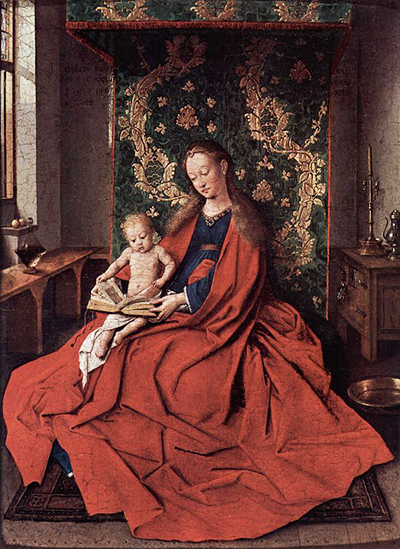The Ince Hall Madonna (The Virgin and Child Reading) refers to a painting by Jan van Eyck which was later lost. Thankfully some accurate copies were made of it, one of which is pictured here.
The copy itself which is owned by the National Gallery of Victoria, Melbourne was as recently as the 1920s still considered to be a genuine Van Eyck painting. Scientific research has since been carried out on several occasions to clarify that it was actually a copy by someone else. It is believed to have been produced at least a decade after Van Eyck's own version but it also likely to be pretty faithful to the original and so can tell us plenty about how the master's original work would have looked. Indeed, we see many of the hallmarks of the artist within the copy and so it seems reasonable to assume that the copy is particularly accurate, especially considering the many considered it to be from his career up until fairly recently. The huge amount of time that has passed since this artist's career has made it difficult to attribute certain items from around that period, particularly as he himself ran a studio in which many artists would collaborate and share ideas on a daily basis, but without necessarily documenting their contributions per artwork.
The relatively simple composition features an indoor scene in which the Virgin and Child are busy reading together. The appear sat on a small bed of wide chair, with an elegant piece of embroidery placed behind them with a swirling floral pattern in gold on green with a red trim. To our left is a window which allows light to flood into the painting, and a small table that lines the wall. Beneath the two figures is a square carpet over a plain floor, though most of this part of the work is covered by a huge garment worn by the Virgin herself. This red cloth keeps her warm whilst she amuses the child. He is perched on a smaller white cloth and intently stares at the book in front of him. Her undergarment is blue, with her hair tidy and a small but modest use of jewellery.
The copy found at the National Gallery of Victoria, Melbourne is fairly small, which is the case for a number of Van Eyck paintings (or copies of them). It would be later on that the likes of Rubens, Rembrandt and the like would start to put together much larger canvases, where as Van Eyck would instead fuse multiple panels together to create various triptchs. Visitors to see the copy in Victoria will also be able to enjoy a fairly impressive collection whose highlights include the likes of Madonna and Child with infant St John the Baptist by Correggio, The Crossing of the Red Sea by Nicolas Poussin, Rachel de Ruvigny, Countess of Southampton by Anthony van Dyck, A Lion Attacking a Horse by George Stubbs and also The Red Rigi by J.M.W. Turner.




